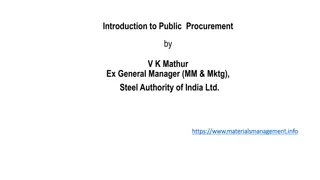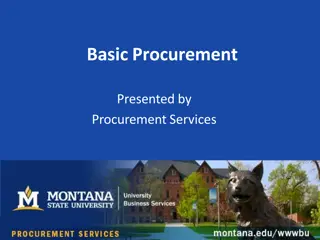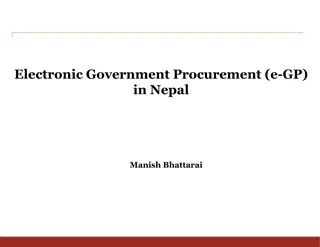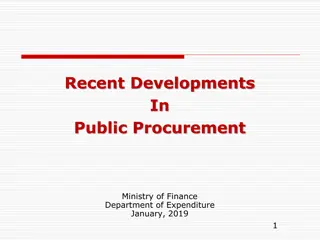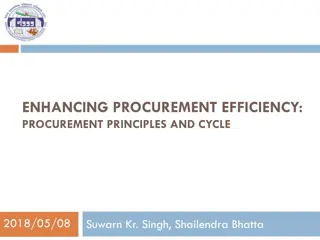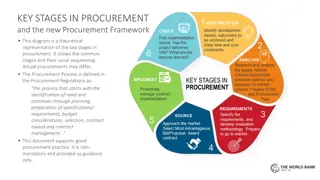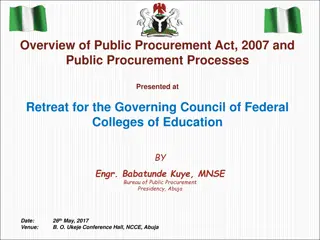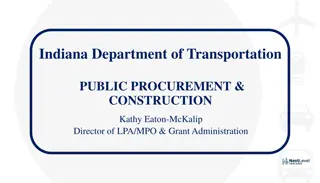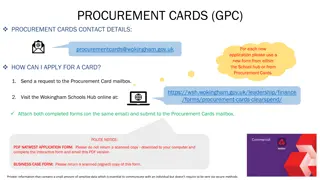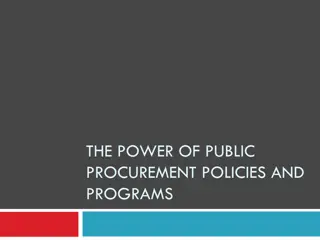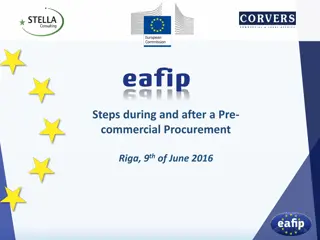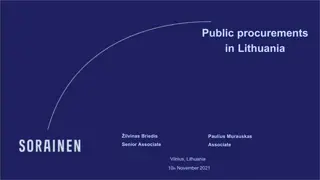Overview of Construction Industry and Procurement Process
The construction industry plays a vital role in national development, encompassing various types of projects from building construction to infrastructure development. Key players include clients, consultants, contractors, and financial institutions. Ethiopian construction projects showcase significant investments in road infrastructure, housing, and energy sectors. The procurement process in construction involves acquiring goods and services to meet project needs efficiently while ensuring fair competition and transparency. This process covers bid preparation, evaluation, and selection of bidders.
Download Presentation

Please find below an Image/Link to download the presentation.
The content on the website is provided AS IS for your information and personal use only. It may not be sold, licensed, or shared on other websites without obtaining consent from the author. Download presentation by click this link. If you encounter any issues during the download, it is possible that the publisher has removed the file from their server.
E N D
Presentation Transcript
General Overview Construction Industry is an industry which is involved in the planning, building, execution and evaluation of all types of civil works. Construction projects can be broadly classified as: Building Construction (includes facilities for habitation, institutional , educational, light industrial (e.g. warehouse), commercial, social and recreational purposes), Engineered Construction (includes highway and heavy (e.g. dams, sewage plant) construction), and Industrial Construction CI is among the leading industry in producing employment and contribute to the overall national development. 2
Cont The main players in the construction industry are: The Client: The Consultant: The Contractor: Insurance Companies: Banks: Suppliers: Permitting Agencies: Public: 3
Too Many Participants Job Subs Supervisors Corporate Management Owners Field Labor RE Agents Suppliers Design Center Manufacturers Sales & Marketing Accounting Banks & Mortgage Lendors Scheduling Local Municipalities 4 Purchasing Estimating
Ethiopian Construction Roads Projects ( More 43 Billion Birr in 5 yrs) Many road projects under the federal & regional state Road authorities. Light weight railway project Hydropower projects Great renascence dam Tekeze Gilgel Gibe I. II, and III Buildings projects Housing projects at federal & regional state level ( 400,000 houses ( 16 B. Birr) The 31 universities. Many health centers. 5
Procurement Outline 1.Procurement 1.1. What is Procurement? 1.2. Contract/project delivery system 1.3. Stages of Civil Engineering projects 1.4. Bid preparation 1.5. Bid evaluation 1.6. Selection of bidders 1.7. Statistical approach in tendering 6
1.PROCUREMENT 1.1What is Procurement? 1.1.1 Procurement Procurementis the acquisition of appropriate goods, works and or services at the best possible total cost of ownership to meet the needs of the purchaser in terms of quality, quantity ,time ,and location. The complete action or process of acquiring or obtaining personnel ,material ,services ,or property by means authorized in pertinent directives. Corporations and public bodies often define processes intended to promote fair and open competition for their business while minimizing exposure to fraud and collusion. 7
Cont In short , Procurement is Obtaining goods , works ,consultancy or other services through purchasing , hiring or obtaining by any other contractual means. Tendering/Bidding : is a stage in the procurement process extending from advertisement (invitation to bid) up to signing of contract. Tender/Bid is an offer which incorporates: the sum of money , time and other conditions required to carry out the contract obligations in order to complete a project or apart of it consisting of specified works. When signed and submitted the Bid/Tender creates a legally binding and valid offer. 8
1.1.2 What is to be Procured? Consultancy Services : a service of an intellectual and advisory nature provided by consultants using their professional skills to study , design and organize specific projects ,advice clients ,conduct training and transfer knowledge. Services : mean any object of procurement not related to professional skills other than works ,good sand consultancy services ; such as transportation ,printing and duplicating books , maintenance , security , electricity , telecommunication and water supply services. 9
1.2 Contract/Project Delivery Methods Contract/project delivery system is the way Project Owners together with Project Regulators and Financiers determine the assignment of responsibilities to Project Stakeholders along the Construction Process. It is often determined during the basic planning phase of the construction project. Delivery systems are basically classified into two broad areas: Force Account, Outsourced. 10
1.2.1 Force Account Definition Work ordered on a construction projectwithout an existing agreement on its cost and performed with the understanding that the contractor will bill the owner according to the cost of labor, materials, and equipment, plus a certain percentage for overhead and profit . When the project owners engage them selves to undertake the project ,it is called a force account delivery system. Such a system is often promoted if the Project Owners believe that there is a comparative advantage in quality ,cost and time. 11
1.2.2 Outsourced delivery systems Most of the project delivery methods/systems are found under the category of out sourcing. The criteria for such category are based on: segmentation , integration and financing. A. Segmented Delivery Methods Design-Bid-Build(DBB); A. Design-Build(DB); B. Construction Management(CM); C. Pure Operation sand Maintenance (O&M) D. 12
Cont 3. Integrated Process Delivery Methods Design-Build-Operate; Design-Build-Operate-Maintain; Design-Build-Finance-Operate; 2. External Financing Methods Design-Build-Finance-Operate; Build-Own-Operate; Build-Own-Operate-Transfer; 13
1.2.2 Outsourced delivery systems A.Segmented Delivery Methods A . Design-Bid-Build , DBB ( Traditional Method ) After Project Owners did prepare the Basic Planning that identifies construction project programs , they call upon the participation of Design and/or Supervision Consultants. This Consultant will carry out the design together with the necessary tender documents which will be the basis for tendering to select Contractors. 14
Cont.. For many years ,DBB has been the most common method of project delivery for public projects ,and form any private projects as well. DBB is effective on projects Where the owner needs both professional design services and construction services. Where the designer does not require detailed knowledge of the means and methods of construction. DBB provides the owner with a high degree of control. 15
Cont (Two Separate Contracts for Design & Construction) 16
Cont Advantages: Disadvantages: Innovation not optimized; Applicable to a wide range of projects, Well established and easily understood, Usually cost overruns; Clearly defined roles for all parties, Disputes between parties; Provides the lowest initial price that Client retains risks; competitive bidders can offer, Usually low bid-incentive Extensive litigation has resulted in well for change orders; established legal precedents, Owner responsible for Insurance and bonding are well defined. errors and omissions. 17
B. Design- Bid , DB (Turnkey) Design Build or Turnkey , in principle , reduces numbers of procurement processes engaged in the fragmented process and employ only one procurement process and a single design build contractor to provide the entire Construction Implementation Process (design and construction ). The design builder performs design and construction according to design parameters , performance criteria and other requirements established by the employer or his representative. In this arrangement both the design and construction liability rests with the Contractor 18
Cont Advantages. Single source responsibility both for design & construction; Integrating design & construction; Reduction in administration; Innovation; Cost savings; Construct ability optimized; Most risks transferred to the design-builder; Design reflects. 19
C. Construction Management , CM Under CM the Owner contracts separately , but some what simultaneously , with a design consultant and with a firm whose primary expertise is construction ( the Construction Manager). The owner procures the management services of the Construction Manager (in most cases a general contracting construction firm) early in the design phase. Types of CM delivery system: CM at Free : as agent, CM at Risk : as a constructor. 20
Advantages may include CM At Risk CM At Free Good for clients with insufficient Provides a managing & staff; administering services for all Responsible for time & cost overrun; phases of a project; Holds & manages the trade Treats planning, design, contractors; construction as an integrated tasks; Constructability design review; Some costs & schedule control; Works closely as a teaming effort & encouraging partnering & trust; 21
Disadvantages may include CM At Free CM At Risk Duplication of administration & No contractual relationship with trade contractors; additional paperwork; More paper work for the client; No contractual responsibility for outcomes Some duplication of administration; of a project; Fast tracking difficult to control with Client retains the risks; designer & CM; Sometimes difficult to manage all phased packages with costs, changes & schedules; 22
D. Design-Build-Operate , DBO According to FIDIC , the DBO approach to contracting combines design , construction , and long term (ex.20 years) operation (and maintenance) of a facility in to one single contract awarded to a single contract or (who will usually be a joint venture or consortium representing all the skills for in a DBO arrangement). The advantages are categorized in terms of : time , finance and quality. 23
Cont Time With possibilities to overlap some design & build activities it will be possible to minimize delays & optimize the smooth flow of construction activities. Finance With cost restraints & commitments & other risks being carried by the contractor, there is less risk of price over-run. Quality With the contractor responsible for 20 years operation, he has an interest to design & build quality plant with low operation & maintenance costs. Not only will then plant be fit for purpose but it will be built to last . The FIDIC has now prepared conditions of contract which facilitate the D-B-O process. 24
E. Build-Operate-Transfer , BOT BOT is a form of procurement and contract delivery system that promotes Public Private Partnership (PPP) in which a private company is contracted to finance , design , construct , operate for a certain period (usually 10 years) and transfer the facility to the Project Owner. The typical BOT project contract is the process where by a government grants a concession to a project development company to develop and operate what would normally be a public sector project , for a given period of time known as the concession period. BOT project involves a potentially complex contractual structure. 25
G. Delivery systems based on Financing method Design-build-operate-transfer ; DBOT Design-build-operate-maintain ; DBOM Design-build-own-operate-transfer ;DBOOT 26
1.3.Stages of Civil Engineering Projects The project life cycle of a construction project may be viewed as a process through which a project is implemented from cradle to grave. 27
Cont The major stages in construction projects encompass: Pre-design stage Design stage Processing construction bids stage Construction stage Completion and handover (contract closeout) 28
1.3.1 Pre-design stage It encompasses the following major activities: Carry out feasibility study, Selection of suitable site, Preparation of tentative cost estimates, Making topography of the site, Preliminary sub-surface investigation. Pre-by Ermias Solomon. 29
1.3.2 Design stage It encompasses the preparation of: Concept design, Preliminary design, Final design, Engineer s cost estimate, Bid documents, Drawing sand design reports. 30
1.3.3 Tender/ Bid stage. What is Tender? Tender is an offer which incorporates the sum of money, time and other conditions required to carry out the contract obligations in order to complete a project or a part of it consisting of specified works . Will be started after the design complete and project budget must be approved . client contractor client sub-contractor consultant main contractor 31
Difference between a contract and a tender A tender formally means an invitation to trade under the terms of offer. A contract is the term used for when the parties have reached agreement. Pre-by Ermias Solomon. 32
Cont The following activities need attention during processing of construction bids. A . Bid documents and related issues: Preparation of bid documents Clarity of bid documents, Validity of bid security, Amendment of bid document (if any), Site visit , Performance Security etc. 33
Cont B . Bid processing and award of contract: Determination of project category (possible procurement method), Competitive bidding (ICB,NCB), Limited/restricted bidding( ICB,NCB), Direct contracting (appointment/ negotiated contract) Force account Announcement of invitation for pre-qualification, Public bid opening, Bid evaluation and award process, Preliminary examination of bids. Evaluating bids. Propose award. Bid evaluation report. Contract award. Rejection of all bids, Preparation of contract document, Signing of contract. 34
1.3.4 Construction stage Construction stage is the critical phase since the result of all prior planning , design and the total pre-construction decisions are brought to fruition. The success of this stage mainly depends on the relation and strength of the construction team (main stake holders). The main activities in construction phase are construction supervision and contract administration. I . Construction supervision : Site control, Quality control, Quantity control, Monthly and quarterly progress evaluation meetings. 35
Cont ii. Contract administration: It covers the major activities of addressing changes , payments ,claims etc. It will be dealt with in detail under chapter2 36
1.3.5 Contract closeout stage Transition from design and construction to the actual use of the constructed facility. The management team must provide documentation , shop drawings , as built drawings , and operation manuals to the owner organization. Assessment of the project team s performance is crucial in this stage for a voiding mistakes in the future. Actual activity costs and durations should be recorded and compared with that was planned. 37
1.4 Bid Preparation 1.4.1 Preparation of Bid Documents The Bidding document shall in corporate all in formation necessary for prospective bidders to prepare their bids. The detail and complexity of bid documents may vary with the size and nature of the proposed bid package and contract. The consultant hired for the job/the client prepares all the design and tender document which includes Legal & Technical section . 38
Cont A) Legal section B) Technical section Invitation to bidders Instruction to bidders Conditions of contract GCC & SCC Tender forms Form of tender Appendix to form of tender Certificate of tender visit to site Form of tender security(bank grantee) Form of agreement Form of performance bank grantee Form of grantee for advance payment Schedule of Supplementary information The contract drawings The specification The bill of quantities The bill of schedule Soil investigation reports Addenda 39
Cont Bid documents for works include: A. Bidding information, Contractual information. B. Contractors are responsible for all duties , taxes and other levies ; hence , bidders shall take these factors into consideration in preparing their bids. 40
Cont A. Bidding Information It s part of a tender document , where bidders are required to respond ( provide their offer , data , information) in accordance with the requirement of the documents within the bidding period. Bidding Information Comprises: Invitation for bid(IFB), Instruction to bidders (ITB), Bid Data Sheet (BDS), Bid forms including BOQ, Addenda(Bid Amendment). 41
Cont.. B. Contractual Information: Documents included in the tender document to furnish bidders with full and detailed information of the project for application after winning the contract. The bidder should utilize such information to provide a fair and reasonable offer to the bidding document. Contractual Information Comprises : Agreement form (Contract Agreement), Standard (General) Conditions of contract, particular or special conditions of contract, Technical specifications and Methods of measurement, Drawings, Appendix to Contract Agreement. 42
1.4.2 Invitation to bidders This is a document that describes , The name of the projects Its locations The principal elements of the work to be done The sources of finance Where & when to obtain the tender documents and the return address and date Amount of bid security Date of site visit and, Pre-bid meeting etc 43
Sample Form of Tender We have no conflict of interest in accordance with the ITB; Date: [insert date] Procurement Ref. No.: [insert tender reference no] Page [insert page no] of [insert total n0 of pages] pages Our firm, its affiliates or subsidiaries - including any subcontractors / suppliers for any part of the contract - has not been debarred from participation in public procurement by the Government of the FDRE, in accordance with the ITB ; To: [insert complete name of Employer] We, the undersigned, declare that: We have read & understood the provisions on fraud and corruption in the ITB and we undertake to abide by the Code of Ethical Conduct for Bidders during the procurement process and the execution of any resulting contract; We have examined and have no reservations to the Bidding Documents, including Addenda No.: [insert the number and issuing date of each Addenda]; We understand that this bid, together with your written acceptance thereof included in your notification of award, shall constitute a binding contract between us, until a formal contract is prepared and executed. We offer to execute the [insert the name & procurement ref. no of the Contract] in conformity with the Bidding Documents for the Contract Price of [insert amount in no & words] Ethiopian Birr, excluding any discounts offered below; We understand that you are not bound to accept the lowest evaluated bid or any other bid that you may receive. The advance payment required is .. . Ethiopian Birr: The discounts offered & the methodology for their application are: We accept / do not accept the appointment of [insert name of . proposed in the BDS] as the ... and propose instead that [insert name] be appointed as . Whose fees and biographical data are attached. Our bid shall be valid for a period of [specify the no of days that the bid is valid for] calendar days from the date fixed for the bid submission deadline in accordance with the ITB, & it shall remain binding upon us & may be accepted at any time before the expiration of that period; Signed: [insert signature] In the capacity of [insert legal capacity of person signing the Bid] Name: [insert complete name of personsigning the Bid] Duly authorized to sign the bid for and on behalf of: [insert complete name of Bidder] Dated on ____ day of _________ , _____ [insert date of signing] We, including any subcontractors / suppliers for any part of the contract, have nationality from the following eligible countries: [insert the nationality of the Bidder, including that of all parties that comprise the Bidder, if the Bidder is a JV, and the nationality of each subcontractor and supplier] Pre-by Ermias Solomon. 44
1.4.3 Time for Preparation of Bids Time for preparation and submission of bids depend on the particular circumstances of the project ,magnitude and complexity of the contract. The time to be all owed for the first call is 30 calendar days to enable prospective bidders to conduct investigations before submitting their bids. In some cases the employer is encouraged to convene a pre-bid meeting and arrange site visits. Concise instructions as to the time , date and place for submission of tenders should be given. 45
Instruction to bidders PPA SBD\Wks-SBD-ICB-Section 2.doc PPA SBD\Wks-SBD-ICB-Section 1.doc The instruction to bidders contains information which is relevant to the tender Preparations such as, A brief description of the works and its location, Validity of tenders Tender security Amount and types of currency as well as bank form Ruling language of the contract documents Site visit dates The employer arranges site visit to acquaint with the prevailing site conditions Pre-bid meeting After site visit pre bid conference will be arranged by the employer to answer question raise by the tenders Dead line of submission of tenders 46
1.4.4 Submission of tender The employer will distribute a blank forms that will be filled by the bidders All bids should be submitted in a sealed envelope marked on the outside with the name of the project and the bidders name & address All tenders received at the closing date are opened & read to be evaluated under established procedures & conditions Any tender that is not submitted through the indicated procedures will be disqualified 47
1.4.5 Evaluation of tender After the invitation to bidders is floated, tenders will submit their proposal to the client carries out an evaluation of the bids through comparisons of different offers The first step in evaluation process is public opening and reading of offer in the presences of all competitors. At this stage the name of the tenders offering bids are readout and recorded with a general check on establishing, Conformity with instruction to bidders Validity of tenders (based on various criteria) Check tender security and Readout & recording of bid prices 48
Cont Subsequent to this the employer /consultant then starts the formal bid evaluation processes The evaluation processes includes the following General contractual and administrative evaluation Technical evaluation Financial evaluation General contractual and administrative evaluation Prior to a detailed bid evaluation a general conformity check is carried out Usually this check insures compliance with the legal/contractual aspect of the contact and may include whether there are deviations or not 49
Cont. Financial evaluation The evaluation of the financial part is straightforward . The prices are corrected for arithmetic errors and then added up and compared with each other , some of the issues that are considered in financial evaluations are: Verifications readout prices Checking of submitted prices are the same as the figures readout during the opening ceremony Check & adjust arithmetic errors, omissions, adjustment, additions. Based on the analysis of the above factor, bids are then compared with each other and then the lowest bid value is then selected 50





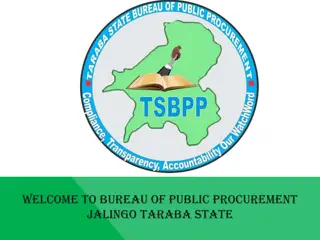
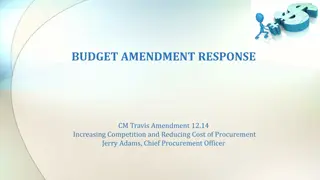
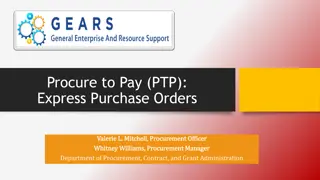
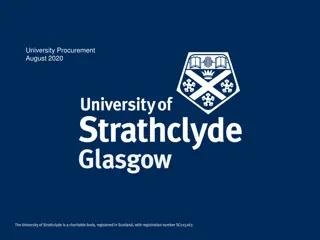
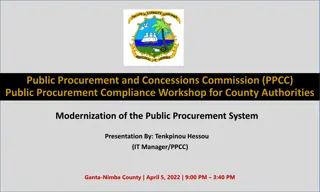
![Comprehensive Overview of Corruption Watch Submission on Public Procurement Bill [B18B-2023]](/thumb/138344/comprehensive-overview-of-corruption-watch-submission-on-public-procurement-bill-b18b-2023.jpg)
